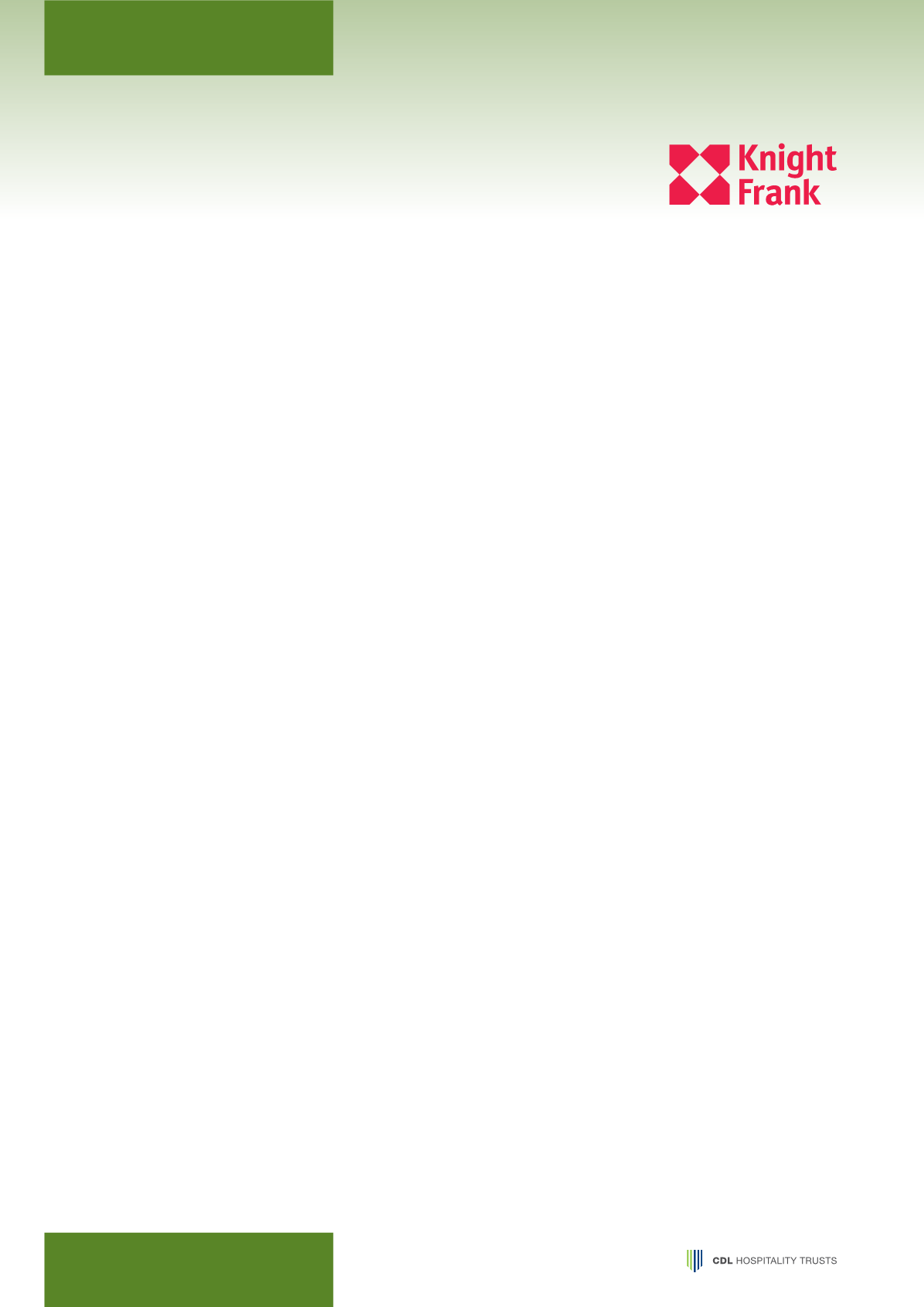
SINGAPORE
HOTEL PROPERTY SECTOR
as of 1 March 2016
MARKET REVIEW
SINGAPORE TOURISM MARKET
The Singapore tourism sector’s lacklustre performance in
2015 could extend to 2016 if growth in global economy
remains weak and corporate travel budget is reduced
according to the STB. Tourism receipts in 2015 fell 6.8% yoy
to S$22 billion, the first decline in six years, and the lowest
overall spend since 2010.
The tepid performance in 2015 was attributed to the decline
in the number and overall spending of BTMICE travellers.
The number of BTMICE travellers fell 6% yoy and their
tourism receipts dipped by 8% yoy according to 3Q 2015
STB data. Leisure visitor arrivals have however increased by
2% yoy in 3Q 2015 mitigating against the drop in BTMICE
visitor arrivals. The increase in leisure visitors was not able
to prevent the decline in tourism receipts as STB shared that
the average BTMICE visitor generally spends about two
times more than the average leisure visitor.
The strengthening Singapore dollar against regional
currencies as well as the uncertain economic outlook
affected key markets from Indonesia, Malaysia, Australia and
Japan where visitor arrivals declined by 9.7%, 5.0%, 2.9%
and 4.3% respectively. On the contrary, Chinese visitors saw
2.11 million visitor arrivals, a 22% yoy increase from 2014.
STB attributed the increase to good growth in tier one and
two cities.
Based on the statistics from the STB as at 29 February 2016,
visitor arrivals in 2015 improved by 0.9% to 15.2 million
compared to 2014 arising from increasing visitor numbers
from key markets in China and India. Visitors from Southeast
Asia saw the biggest decline of 6% decrease yoy led by
the biggest drop in visitor arrivals from Indonesia (-9.7%),
Brunei Darussalam (-5.2%), Myanmar (-6.5%) and Malaysia
(-5.0%). Visitors from North Asia support the overall
numbers as overall visitors in this region increased by 10%
yoy led by visitors from China (22.3%) and Taiwan (12%).
In terms of geographical breakdown of annual international
visitor arrivals in 2015, Indonesians (17.9%) still form
the biggest share followed by the Chinese (13.8%),
the Malaysians (7.7%), the Australians (6.9%) and the Indians
(6.7%). These five market segments constitute 53.0% of
total market share.
From the visitor arrival performance in 2015, visitor arrivals
and tourism receipts from the leisure segment continue to
grow lending optimism that Singapore continues to remain
an attractive holiday destination. To address the decline in
BTMICE visitor numbers, STB broadened marketing efforts
such as global campaigns to position Singapore as top
business destination and to enhance Singapore destination
attractiveness. To boost industry competitiveness, STB
embraces collaborative efforts with its tourism partners such
as hotel operators to enhance productivity and manpower
related initiatives for other tourism industries.
STB also saw over 80 submissions to tap on its S$10 million
Experience Step-Up Fund which aimed to get businesses
to develop new tourism experiences. It has also awarded
grants to nine projects in 2015 under its S$5 million Kickstart
Fund for the purpose of extending support for innovative
lifestyle events and concepts that have strong tourism
appeal.
For 2016, STB expects visitor arrivals to grow from 0% to 3%
at 15.2 million to 15.7 million compared to 2015. Tourism
receipts are expected to grow by 0% to 2% at S$22 billion
to S$22.4 billion over the same period.
In the medium term, STB is optimistic about Singapore
tourism growth prospects. Singapore is poised to benefit
from the projected growth in outbound travel in Asia-Pacific
and the pipeline for business events continues to be strong.
Recent developments augur well for Singapore as a
destination of choice among business travellers. Singapore
was ranked top by Union of International Associations as the
top international meeting city for the eighth year running
top amongst Asia Pacific cities by International Congress
and Convention Association for the 13
th
consecutive
year. Singapore has also secured several high profile and
prestigious BTMICE events over the next few years which is
evident of her status as a destination of choice.
This is also in line with United Nations World Tourism
Organisation’s forecast that the strongest tourism growth
will be seen in Asia and the Pacific and that visitor arrivals to
Asia are expected to increase at about 5% per year to 2030.
Moving forward, STB expects tourist spending to grow at
4% to 6% per annum in the next decade compared to a
compounded growth rate of 13% between 2003 and 2013.
The growth momentum is attributed in part to the following
reasons. Firstly, the proliferation of low cost airlines in Asia,
resulting in affordable air travel to a wider population.
Secondly, the growing Asian middle class with a higher
disposable income and hence a higher propensity to
travel. Thirdly, the addition of major tourism projects like
the two Integrated Resorts and the hosting of major events
of worldwide appeal such as the Formula One Singapore
Grand Prix and WTA Championship. Singapore’s appeal has
been validated by international sources - Lonely Planet has
named Singapore as the top destination among countries in
Best in Travel 2015.
Singapore’s tourism landscape will continue to be enhanced
through new additions and soft programmings such as the
National Gallery Singapore which opened on 24 November
2015, as well as the expansion of the Singapore Zoo in
2020. The WTA Championship which was held in October/
November 2015 marked another successful conclusion of a
major sporting event and had attracted more than 130,000
spectators to the event and a yoy increase of more than
30% in ticket demand from overseas markets.
Apart from leisure and holiday makers, MICE business
travellers are also drawn to the many state-of-the-art
venues that the city-state offers. Singapore was rated the
most competitive ASEAN destination and 11
th
globally by
the World Travel and Tourism Council in 2015. The country
was given high scores for measures such as business
environment, safety and security, health and hygiene, ICT
28


